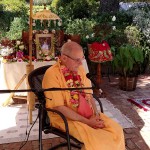LIVE IN SPLIT 2006
LIVE IN SPLIT 2006
→ GITA COACHING
Ganga View
- TOVP.org
This photo from the Ganga showcases what the finished TOVP will look in the natural surroundings of Mayapur. Its size compared to Prabhupada’s samadhi is astounding.
Bhakti Bringa Govinda Swami Maharaj. Friday kirtan. SPb. 14.06.2013
→ Gouranga TV - The Hare Krishna video collection
Bhakti Bringa Govinda Swami Maharaj. Friday kirtan. SPb. 14.06.2013
We Have To Guard Ourselves
→ Japa Group
We Have To Guard Ourselves
→ Japa Group
Srila Tamal Krishna Goswami’s Vyasa-puja Celebration, June 29, Carpinteria, California
Giriraj Swami
 “As he’d done when we’d walked the streets of New York City, he instructed me how to walk the paths of Raman Reti—how to deal with the monkeys. First, you carry a stick with you. We grew up in kind of tough neighborhoods. He sometimes said that the choice for him of which way to walk home was whether to get beat up by this gang or by that gang. So, he knew how to deal with the streets and taught me that. And the way to deal with the monkeys was to just glance at them once to let them know that you know that they are there. Then you go on your way. So, he had a walking stick with a few designs on it that was a little smaller on the bottom than the top. One morning, there were some Vraja-vasi boys playing with a small ball, and we grew up playing stickball, so he reversed his cane and had the boys throw the ball to him like he was lining up at the plate, playing stickball in the dust of Vrindavan. It made a powerful connection for me.” — Kalachandji das
“As he’d done when we’d walked the streets of New York City, he instructed me how to walk the paths of Raman Reti—how to deal with the monkeys. First, you carry a stick with you. We grew up in kind of tough neighborhoods. He sometimes said that the choice for him of which way to walk home was whether to get beat up by this gang or by that gang. So, he knew how to deal with the streets and taught me that. And the way to deal with the monkeys was to just glance at them once to let them know that you know that they are there. Then you go on your way. So, he had a walking stick with a few designs on it that was a little smaller on the bottom than the top. One morning, there were some Vraja-vasi boys playing with a small ball, and we grew up playing stickball, so he reversed his cane and had the boys throw the ball to him like he was lining up at the plate, playing stickball in the dust of Vrindavan. It made a powerful connection for me.” — Kalachandji das
———————————————————————————————————————————–












———————————————————————————————————————————–
Balarama das
Hridayananda das Goswami
Kalachandji das
Indranila Mani dasi
Sraddanjali dasi
Devadahiti dasi
Syamali dasi
Revati dasi
Nagapatni dasi
Sarvatma das
Rama das
Nick Pritchard
Radhapadadhuli dasi
Rtadhvaja Swami
Giriraj Swami
The Tongue Is Sevonmukha-jihva
→ Japa Group

If one chants and accepts the holy name as a material vibration, he falls down. One should worship and chant the holy name of the Lord by accepting it as the Lord Himself. During the chanting of the holy name, the tongue must work; the tongue is sevonmukha-jihva-it is controlled by service.
Caitanya-caritamrita
The Tongue Is Sevonmukha-jihva
→ Japa Group

If one chants and accepts the holy name as a material vibration, he falls down. One should worship and chant the holy name of the Lord by accepting it as the Lord Himself. During the chanting of the holy name, the tongue must work; the tongue is sevonmukha-jihva-it is controlled by service.
Caitanya-caritamrita
Madhava Naidoo and Guests Visit ISCOWP
→ Life With the Cows and Land
Madhava Naidoo and Guests Visit ISCOWP
→ Life With the Cows and Land
Higher vs Lower Knowledge
→ 16 ROUNDS to Samadhi magazine |

Progress in the field of lower knowledge, such as the progress in technology, is not really a progress. Real progress is progress in higher knowledge. This was a Krishna Lounge discussion.
Glastonbury festival 2013
→ simple thoughts
Glastonbury Festival 2013
This must be the biggest music festival in the world.
Nice people come from all over the planet to experience this event.
A few months ago we posted an article on Dandavats, explaining how the festival organisers had gone corporate on us, they wanted us to buy our own tickets, not distribute prasad and that we would not get a good site for the tent.
Well, people complained, the organisers visited Dandavats and low and behold they gave us full facilities again, thanks Dandavats.
Enjoy the movie,be warned,it is not for those with a stanch imposition
Your servant
Parasuram Das
July 2013
→ 16 ROUNDS to Samadhi magazine |
314. Talking Windows
→ 9 Days, 8 Nights
There is a new commercial ad delivery system coming our way. Talking train windows. Yup – as you drop your head against the train window to have a sleep, an ad is played to your ear which only you can hear. Check out the video to get an idea.
I was thinking – what would really help these tired urban hard working people are small spiritual quotes and instructions that can be served to their year using the same medium. Atleast that way, they can improve their lives and those of others too.
Higher vs. Lower Knowledge
→ Krishna Lounge
love vs. lust
→ everyday gita
Have you ever heard of the expression "transforming lust into love"? If so, you might not have known it at the time, but you were actually hearing the very essence of the Gita.
Although certain imagery or thoughts may come to mind when we think of the word lust, the Gita explains that that it is a transformation of love.
So what does love really mean then? Yoga defines love, in its highest form, to be the natural inclination of the soul to give pleasure to the Supreme. If you really meditate on that definition, it makes a lot of sense.
We all, by nature, are seeking that person who will provide us with all our necessities, never abandon us, is capable of loving us completely and is the only person who truly understands how we feel. Am I right or am I right? ;)
It's no coincidence that the Gita, along with all other authorized spiritual texts, give us one unanimous answer to that question - the Supreme.
If it's natural that we love the Divine, then why is it so hard for some of us to access that love. Why do we turn to so many other things? That question is answered here today: Because we are clouded by lust.
"When the soul's natural affection for the Supreme is misplaced, by trying instead to enjoy the property of the Supreme instead of engaging in a relationship with the Supreme, then that love is transformed into lust"
In other words, due to lifetimes of taking on different bodies, we've forgotten our love for the Divine. Instead, some of us try to fill the God-shaped hole in our hearts with all sorts of gadgets, people and situations that we think might make us happy. If that doesn't work and we feel dejected, frustrated and become angry), we still keep trying to seek eternal happiness through our temporary material bodies.
Many of us are under a type of amnesia. The only cure to re-awaken to our natural position of happiness is to associate with those persons who have come out from the fog and confusion. That's why bhakti yoga is a transformation of the heart, not just the mind or intelligence. By practicing mantra meditation, reading bhakti texts and spending time with advanced bhakti practitioners, we start to remember who we really are and gratitude starts to infuse the heart.
That gratitude is the path by which love can develop and we can truly remember who we are.
For many of us:
Life is a journey to find true love.
That true love is waiting for us. We just need to clear the fog of lust and realize that our greatest happiness is not found outside ourselves, but by connecting to the Supreme.
love vs. lust
→ everyday gita
Have you ever heard of the expression "transforming lust into love"? If so, you might not have known it at the time, but you were actually hearing the very essence of the Gita.
Although certain imagery or thoughts may come to mind when we think of the word lust, the Gita explains that that it is a transformation of love.
So what does love really mean then? Yoga defines love, in its highest form, to be the natural inclination of the soul to give pleasure to the Supreme. If you really meditate on that definition, it makes a lot of sense.
We all, by nature, are seeking that person who will provide us with all our necessities, never abandon us, is capable of loving us completely and is the only person who truly understands how we feel. Am I right or am I right? ;)
It's no coincidence that the Gita, along with all other authorized spiritual texts, give us one unanimous answer to that question - the Supreme.
If it's natural that we love the Divine, then why is it so hard for some of us to access that love. Why do we turn to so many other things? That question is answered here today: Because we are clouded by lust.
"When the soul's natural affection for the Supreme is misplaced, by trying instead to enjoy the property of the Supreme instead of engaging in a relationship with the Supreme, then that love is transformed into lust"
In other words, due to lifetimes of taking on different bodies, we've forgotten our love for the Divine. Instead, some of us try to fill the God-shaped hole in our hearts with all sorts of gadgets, people and situations that we think might make us happy. If that doesn't work and we feel dejected, frustrated and become angry), we still keep trying to seek eternal happiness through our temporary material bodies.
Many of us are under a type of amnesia. The only cure to re-awaken to our natural position of happiness is to associate with those persons who have come out from the fog and confusion. That's why bhakti yoga is a transformation of the heart, not just the mind or intelligence. By practicing mantra meditation, reading bhakti texts and spending time with advanced bhakti practitioners, we start to remember who we really are and gratitude starts to infuse the heart.
That gratitude is the path by which love can develop and we can truly remember who we are.
For many of us:
Life is a journey to find true love.
That true love is waiting for us. We just need to clear the fog of lust and realize that our greatest happiness is not found outside ourselves, but by connecting to the Supreme.
Check Out the Exciting Upcoming Events – Attention All Kirtan and Yoga Enthusiasts!
→ Gaura-Shakti Kirtan Yoga
 -Yonge-Dundas Square - Saturday, July 6th
-Yonge-Dundas Square - Saturday, July 6th -12 pm -10 pm-
Can’t wait for Yoga Meltdown on July 14th? No problem! Come and join us for the Festival of India launch party on Yonge-Dundas Square. The pre-festival is held on July 6th 2013, one week before the Festival of India itself.
Kirtan with Madhava and many more renowned kirtaneers at 6 pm promises to transform the heart of downtown Toronto into a sublime experience! In addition to the yoga classes and kirtan, the pre-festival will also feature a South Asian bazaar, vegetarian cooking demos, henna tattoos, face-painting, and dress-in-a-sari booths, and more. To register - http://www.festivalofindia.ca/Festivities/prefestival
 -12-hour Kirtan - Friday, July 12th
-12-hour Kirtan - Friday, July 12th- 10 am-10 pm-
12 hour kirtan with renowned singers from around the world, it can only be described as a ‘kirtan explosion’ that will certainly shake Toronto! Join us for the blissful kirtan day on Friday, July 12th from 10 am to 10 pm at the famous Hare Krishna Centre on 243 Avenue Road! We promise it will be an unforgettable experience!
-Yoga Meltdown - Sunday, July 14th-
 Come join us on Sunday July 14th, 2013 on Centre Island for the 6th Annual Yoga Meltdown, Toronto's largest, free outdoor spiritual yoga and kirtan exhibition. With free outdoor yoga classes, kirtan, mantra meditation sessions, yoga-inspired performances, vegan cooking demonstrations, a free vegetarian feast, and much more, the Sixth Annual Yoga Meltdown celebrates yoga in a dynamic and uniquely holistic way.
Come join us on Sunday July 14th, 2013 on Centre Island for the 6th Annual Yoga Meltdown, Toronto's largest, free outdoor spiritual yoga and kirtan exhibition. With free outdoor yoga classes, kirtan, mantra meditation sessions, yoga-inspired performances, vegan cooking demonstrations, a free vegetarian feast, and much more, the Sixth Annual Yoga Meltdown celebrates yoga in a dynamic and uniquely holistic way.We would love to see you all there to enjoy a FREE yoga class and partake in the festival festivities! Please register in advance: http://www.yogameltdown.com/
Check Out the Exciting Upcoming Events – Attention All Kirtan and Yoga Enthusiasts!
→ Gaura-Shakti Kirtan Yoga
 -Yonge-Dundas Square - Saturday, July 6th
-Yonge-Dundas Square - Saturday, July 6th -12 pm -10 pm-
Can’t wait for Yoga Meltdown on July 14th? No problem! Come and join us for the Festival of India launch party on Yonge-Dundas Square. The pre-festival is held on July 6th 2013, one week before the Festival of India itself.
Kirtan with Madhava and many more renowned kirtaneers at 6 pm promises to transform the heart of downtown Toronto into a sublime experience! In addition to the yoga classes and kirtan, the pre-festival will also feature a South Asian bazaar, vegetarian cooking demos, henna tattoos, face-painting, and dress-in-a-sari booths, and more. To register - http://www.festivalofindia.ca/Festivities/prefestival
 -12-hour Kirtan - Friday, July 12th
-12-hour Kirtan - Friday, July 12th- 10 am-10 pm-
12 hour kirtan with renowned singers from around the world, it can only be described as a ‘kirtan explosion’ that will certainly shake Toronto! Join us for the blissful kirtan day on Friday, July 12th from 10 am to 10 pm at the famous Hare Krishna Centre on 243 Avenue Road! We promise it will be an unforgettable experience!
-Yoga Meltdown - Sunday, July 14th-
 Come join us on Sunday July 14th, 2013 on Centre Island for the 6th Annual Yoga Meltdown, Toronto's largest, free outdoor spiritual yoga and kirtan exhibition. With free outdoor yoga classes, kirtan, mantra meditation sessions, yoga-inspired performances, vegan cooking demonstrations, a free vegetarian feast, and much more, the Sixth Annual Yoga Meltdown celebrates yoga in a dynamic and uniquely holistic way.
Come join us on Sunday July 14th, 2013 on Centre Island for the 6th Annual Yoga Meltdown, Toronto's largest, free outdoor spiritual yoga and kirtan exhibition. With free outdoor yoga classes, kirtan, mantra meditation sessions, yoga-inspired performances, vegan cooking demonstrations, a free vegetarian feast, and much more, the Sixth Annual Yoga Meltdown celebrates yoga in a dynamic and uniquely holistic way.We would love to see you all there to enjoy a FREE yoga class and partake in the festival festivities! Please register in advance: http://www.yogameltdown.com/
ONE OF THE BEST-KEPT SECRETS OF THE SUCCESSFUL
→ Gita Coaching
ONE OF THE BEST-KEPT SECRETS OF THE SUCCESSFUL
→ GITA COACHING
“Immortal College” by my granddaughter Gracie, 9 1/2
→ View From a New Vrindaban Ridge
Mahavishnu Swami and the devotees at Glastonbury Festival, having a 5 hour midni…
→ Mahavishnu Swami
Mahavishnu Swami spent the past week at Glastonbury Festival, one of the biggest…
→ Mahavishnu Swami
Gopicandra asks: Is it true that 75% of devotees are headed for the heavenly planets and if so where are the other 25% going – Goloka or do they stay on earth?
→ SivaramaSwami.com
Urban Meditations
→ The Loft Yoga Lounge Auckland
Tonight ” Our Rights & Freedoms” – a discussion and presentation with Bhadrasena on, ” Our Rights & Freedoms are being undermined & stripped away ” , how does a mystic or yogi respond to this .. Great talks about how to make our way through the ever changing econ/poli, social climates? See you at [...]
The post Urban Meditations appeared first on The Loft Yoga Lounge Auckland.
A Ray Of Vishnu
→ Gouranga TV - The Hare Krishna video collection
A Ray Of Vishnu
313. “The Life-Changing Loaf of Bread” recipe by Sarah Britton
→ 9 Days, 8 Nights
The Life-Changing Loaf of Bread
Ingredients:
1 cup / 135g sunflower seeds
½ cup / 90g flax seeds
½ cup / 65g hazelnuts or almonds
1 ½ cups / 145g rolled oats
2 Tbsp. chia seeds
4 Tbsp. psyllium seed husks (3 Tbsp. if using psyllium husk powder)
1 tsp. fine grain sea salt (add ½ tsp. if using coarse salt)
1 Tbsp. maple syrup (for sugar-free diets, use a pinch of stevia)
3 Tbsp. melted coconut oil or ghee
1 ½ cups / 350ml water
Directions:
Find it in the link below on Sarah Britton’s cooking blog
via The Life-Changing Loaf of Bread | My New Roots.
You will find some amazing and very easy menu ideas for your plate from Sarah’s blog. Easy read, healthy recipes and great photos.
(c) Image from Sarah Britton’s My New Roots Blog article
312. Boy Realises Where Meat Comes From
→ 9 Days, 8 Nights
Luiz Antonio questions where his dinner came from.A video has gone viral of a Portuguese boy, Luiz Antonio, explaining to his mum why he doesn’t want to eat octopus gnocchi for dinner, saying that animals should be taken care of and not eaten
via Boy Realises Where Meat Comes From | Essential Kids.
Interesting news and video this one. Even a child knows about compassion. Why do adults have a strong distaste for love and care for other living beings? Why are they so adamant that they want to use animals and birds for experiments, sports and taste? Is is this our so-called advancement?
On another note, we can also see he is bringing his past life habits and desires into this life. Otherwise, it is very hard to have such strong views right from an early age. Perhaps, in a life prior to this, the boy must have been a strong advocate of animal rights and protection. He has taken another birth to carry on his mission. Good luck Luiz !
Without Hearing How Will You Chant
→ The Enquirer
We should all read Śrīmad Bhāgavatam more carefully. It is the foundation of our entire spiritual practice, for without hearing attentively and with an ear for detailed comprehension, how will we invest our consciousness into chanting? And without chanting attentively, how will we expect to make any advancement towards a transcendental goal? By winning a lotto-6 of so-called “causeless mercy”??? That fails to recognize that the transcnedental goal is personal transformation, which cannot be effected without our personal involvement. No one else can do it for us. It all starts with hearing Śrīmad Bhāgavatam very carefully, with strong curiousity.
If by chance my attempt to do so is of service to you, all the gurus, headed ultimately by the Goddess, Śrīmatī Rādhārāṇī will be merciful to me and look on me favorably. Please bless me by finding something of inspirational value in my work on Śrīmad Bhāgavatam.
Your servant,
Vraja Kishor das
GITA COACHING FOR YOUR SUCCESS AND HAPPINESS
→ Gita Coaching
GITA COACHING FOR YOUR SUCCESS AND HAPPINESS
→ GITA COACHING
Deity Darshan: Snana Yatra
→ The Toronto Hare Krishna Blog!
Experiencing Krishna while Living in the World
→ Karnamrita.das's blog
(this blog is recorded on the full page: quick time player needed; works best with Firefox or Explorer)
 [Originally published on July 1, 2013, though the topic is timeless, the endeavor constant]Two of the top difficult things to understand—out of many—for new readers of Bhagavad gita are the personhood of Krishna, and his Universal Form. Of course they are related, since Krishna reveals that the Universal Form comes from him, and is a manifestation of his energy as the material world. In particular this display of the Universal Form (there are others), though inspiring to show the greatness and inconceivableness of God, is also at times ghastly and fearsome, and as a form of time, “the destroyer of the worlds,” all of which may be disconcerting. While Krishna is both the creation and annihilation of everything he is also the seed of all existence, the life of all that lives, and the soul of our souls, so we have to look at the whole picture before being able to evaluate who Krishna is.
[Originally published on July 1, 2013, though the topic is timeless, the endeavor constant]Two of the top difficult things to understand—out of many—for new readers of Bhagavad gita are the personhood of Krishna, and his Universal Form. Of course they are related, since Krishna reveals that the Universal Form comes from him, and is a manifestation of his energy as the material world. In particular this display of the Universal Form (there are others), though inspiring to show the greatness and inconceivableness of God, is also at times ghastly and fearsome, and as a form of time, “the destroyer of the worlds,” all of which may be disconcerting. While Krishna is both the creation and annihilation of everything he is also the seed of all existence, the life of all that lives, and the soul of our souls, so we have to look at the whole picture before being able to evaluate who Krishna is.
Krishna could have demonstrated his nature as the creator and maintainer by showing baby animals, lovely human children, beautiful scenes in Nature, the universe being incredibly sustained and flourishing, but specifically to get Arjuna’s attention, he wanted to encourage Arjuna in his duty of fighting by showing him that the great warriors he had to fight were already killed by Krishna’s power--in fact we all must die, our bodies that is, at our allotted time. For conditioned living beings, the Universal Form teaches us that the material world is temporary, and not really suitable for eternal souls to live, since bodies, planets, and the entire Universe are constantly changing, and will ultimately be vanquished. The point is that Krishna is present in all things and, through his energy, is everything. His greatness is all-sided and unlimited, manifested in the subatomic dimension and as the whole universe—in the micro and macro-cosmic level. For us imperfect and limited souls, he can be experienced in what we can observe. Though we can’t perceive his spiritual form, or even our own souls, we can, by the grace of the Bhagavad Gita, Shrimad Bhagavatam, and the mercy of the devotees who live by such revealed Vedic literature, “see” him, specifically in “…all opulent, beautiful and glorious creations…”[ Bg 10.41].
In what follows I will share some highlights of these manifestations of Krishna from the Bhagavad Gita, which is another version of the Universal Form, or Krishna’s material form.
Experiencing Krishna while Living in the World
→ Karnamrita.das's blog
(this blog is recorded on the full page: quick time player needed; works best with Firefox or Explorer)

Two of the top difficult things to understand—out of many—for new readers of Bhagavad gita are the personhood of Krishna, and his Universal Form. Of course they are related, since Krishna reveals that the Universal Form comes from him, and is a manifestation of his energy as the material world. In particular this display of the Universal Form (there are others), though inspiring to show the greatness and inconceivableness of God, is also at times ghastly and fearsome, and as a form of time, “the destroyer of the worlds,” all of which may be disconcerting. While Krishna is both the creation and annihilation of everything he is also the seed of all existence, the life of all that lives, and the soul of our souls, so we have to look at the whole picture before being able to evaluate who Krishna is.
Krishna could have demonstrated his nature as the creator and maintainer by showing baby animals, lovely human children, beautiful scenes in Nature, the universe being incredibly sustained and flourishing, but specifically to get Arjuna’s attention, he wanted to encourage Arjuna in his duty of fighting by showing him that the great warriors he had to fight were already killed by Krishna’s power--in fact we all must die, our bodies that is, at our allotted time. For conditioned living beings, the Universal Form teaches us that the material world is temporary, and not really suitable for eternal souls to live, since bodies, planets, and the entire Universe are constantly changing, and will ultimately be vanquished. The point is that Krishna is present in all things and, through his energy, is everything. His greatness is all-sided and unlimited, manifested in the subatomic dimension and as the whole universe—in the micro and macro-cosmic level. For us imperfect and limited souls, he can be experienced in what we can observe. Though we can’t perceive his spiritual form, or even our own souls, we can, by the grace of the Bhagavad Gita, Shrimad Bhagavatam, and the mercy of the devotees who live by such revealed Vedic literature, “see” him, specifically in “…all opulent, beautiful and glorious creations…”[ Bg 10.41].
In what follows I will share some highlights of these manifestations of Krishna from the Bhagavad Gita, which is another version of the Universal Form, or Krishna’s material form.
Newcastle Food for Life
→ Ramai Swami

The city of Newcastle has a population of over half a million people and is situated about two hours north of Sydney. It was once the headquarters of mining giant BHP, which has now ceased most of its operations.
The city is the country regional hub for the Hunter Valley with more than a million people living in the area. It has a big university that caters to local students as well as students from nearby towns.
For many years we operated a restaurant, shop and preaching centre in the city central. However, a big development company bought out the city block where our restaurant was located and made us an offer we couldn’t refuse.
In the beginning of June we purchased a shop with two apartments at back in the Mayfield area of Newcastle. This is just a ten minute drive from the university where we operate a Vegie club 4 or 5 times a week. Many students who eat at the Vegie club visit our farm at Millfield.
Over the next few months we will set up the shop as a Hare Krishna Food for Life premises, where we will cater for the Vegie Club as well as provide cheap meals from the shop itself. We will also hold regular Kirtan, prasadam and lecture classes from there.
Setting A Goal For Chanting
→ Japa Group
Speed comes naturally and the main thing is chanting your rounds with the mind focused in the mantra. Today I had a nice experience with that - we need to set a goal in chanting and I did that today.
I set this goal of chanting a certain number of rounds without stopping for anything, just focus on the mantra and go on, any time my mind tried to force me to do something else I ignored and kept on chanting, until my goal was fulfilled and my rounds finished. I felt so good after that and I felt I could control my mind any time just because the mantra was in charge of that.
Hoping you have a great week of chanting.
your servant,
Aruna devi







